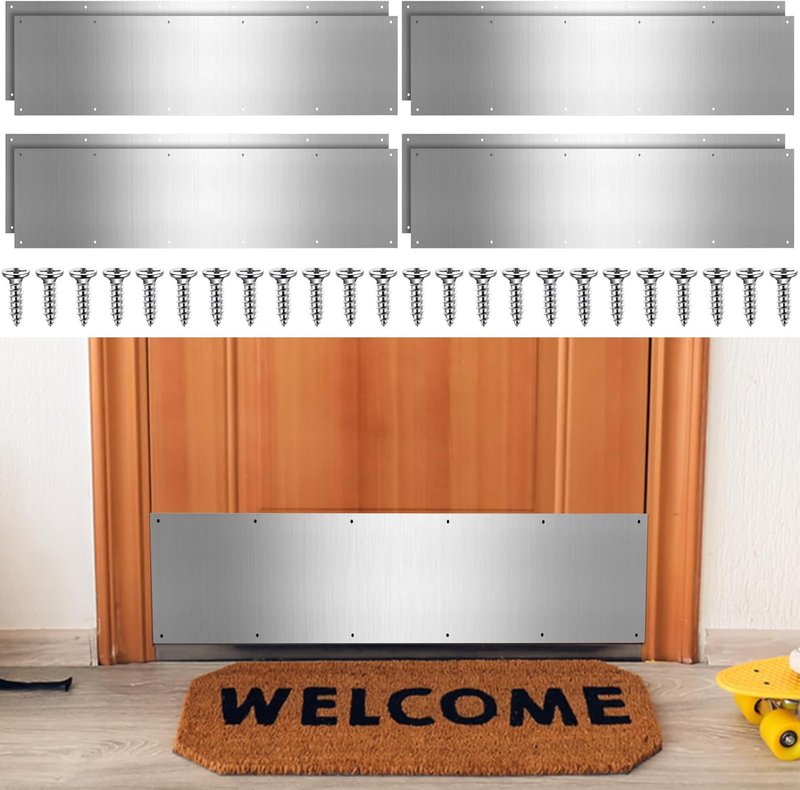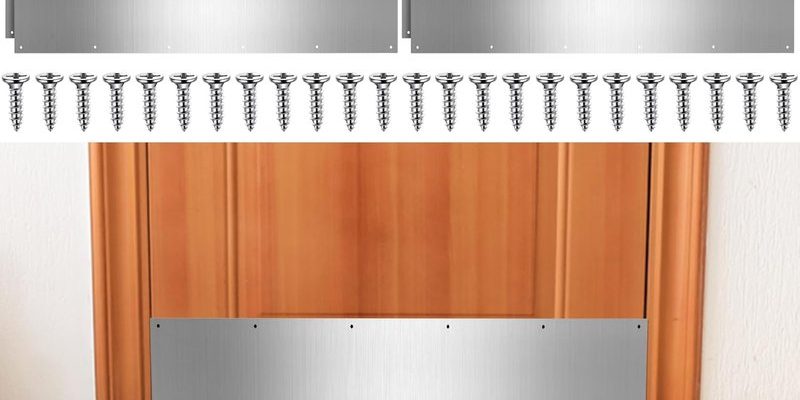
Choosing a kick plate for extreme weather isn’t just about picking something shiny. You need something that can swap punches with sleet, mud, salt, and snow boots—all year, every year. There are dozens of brands and materials out there, but only a few can really handle the rough stuff. Let me walk you through how to spot the best ones, when it matters most.
Why Kick Plates Matter In Harsh Weather
You might be wondering—is a kick plate really necessary? Honestly, if you live where seasons get messy, the answer’s yes. Doors take a daily beating. Shoes stomp in snow, pets scratch, rainwater drips, and salty slush eats away at paint or wood. Over time, the bottom of your door can look pretty rough.
Kick plates step in to take the brunt of that abuse. They protect your door from scratches, dents, and rot. That’s not just about looks; it can also save you serious cash on repairs down the line. In extreme weather, they do double duty by helping to keep moisture out of vulnerable edges and making cleanup easier—just wipe the plate instead of scrubbing the door itself.
Here’s the thing: not all kick plates are made equal. Some are purely decorative, while others are built to take a pounding. Especially in wet, snowy climates, you’ll want one that’s both tough and rust-resistant, or you’ll be replacing it every couple of years. Trust me—once you’ve had the right kick plate, you’ll never want to go back.
Key Features To Look For In Kick Plates For Rain & Snow
When you’re shopping for a kick plate that can stand up to extreme weather, focus on materials and build quality first. Sure, style matters—but if the plate falls apart after one tough winter, it’s not much good.
- Material: Stainless steel, aluminum, and heavy-duty brass are the best bets for wet, snowy places. These metals don’t rust easily, and they can handle the scrub-downs that happen after mucky weather.
- Finish: Look for a powder-coated or anodized finish. These coatings add a layer of protection, helping your plate resist corrosion and keep its shine even after months of salt and slush.
- Thickness: A thicker plate (at least .050″ if you can find it) will last longer and prevent bending from hard kicks or shovels knocking against it.
- Mounting options: Most kick plates use screws, but adhesive backing is available for some models. Screws hold up better in heavy weather, but adhesive offers a clean look if you’re worried about holes.
If you’re still not sure, check reviews for your chosen brand—what are people saying about durability after a brutal winter? Real-world stories can tell you a lot.
Stainless Steel vs Aluminum vs Brass Kick Plates
Let me explain what each material brings to the table. Imagine you’re picking armor for your door—some plates are lightweight but tough, while others are heavy hitters with extra shine.
Stainless steel kick plates are the classic choice for harsh climates. They’re naturally rust-resistant, hard as nails, and can handle salty slush without corroding. The only downside? They’re heavier, which can be overkill for lighter doors, but for storm doors or thick wood, they’re gold.
Aluminum kick plates are lighter and still offer solid protection. They don’t rust, but they can dent more easily than steel. The upside is that aluminum plates are often cheaper, and if you choose an anodized finish, they’ll stay looking good even after a bunch of storms.
Brass kick plates are the showstoppers. They look classy and resist corrosion (especially unlacquered brass), but they do tarnish over time—some people love the patina, but if you want a bright, shiny finish year-round, brass might take a little more care.
Pro tip: For the absolute worst weather, stainless steel is usually the safest bet. But if weight or budget is a concern, aluminum is still a solid runner-up.
Top Brands That Excel In Extreme Weather
If you’re feeling overwhelmed by all the options, don’t worry—I’ve got you. Some brands just do this better, especially for messy climates.
- Schlage: Best known for locks, but their stainless steel kick plates are tough, easy to install, and have a clean, modern look. They’re a favorite for storm doors or entryways that get soaked by winter splashback.
- Don-Jo: These guys have a long history in the hardware game. Their aluminum kick plates come in a range of finishes, and real-world users report they last through years of salt and snow with barely a scratch.
- IVES by Schlage: If you want brass, IVES delivers thick, commercial-grade plates. Their powder-coated options hold up even better in damp climates, so you don’t have to trade style for strength.
- Rockwood: Heavy-duty, commercial-level plates that work at fire stations, schools, and anywhere else that sees constant foot traffic—and weather abuse. Overkill for most homes, but perfect if you want “set it and forget it” durability.
Insight: Don’t get swayed by bargain brands with thin metals or cheap screws. When it comes to extreme weather, cut corners and you’ll end up back at the hardware store way sooner than you’d like.
Installation Tips For Weatherproof Kick Plates
Installing a kick plate can be a quick DIY job, but a few extra steps can make your plate last longer—especially in places with heavy rain or snow.
First, always clean and dry the bottom of your door before you start. If there’s old paint peeling or signs of rot, tackle those first. Laying a kick plate over damp wood is just asking for trouble.
If you’re using screws, line up the plate evenly along the bottom edge, then pre-drill your holes. This stops the metal from warping and keeps your door from splitting. For adhesive plates, make sure the surface is totally dry (use a hairdryer if you need to). Press firmly along the whole plate for a tight, weather-tight seal.
A little caulk around the edges can help keep water and ice from sneaking between the plate and the door, but don’t overdo it—water still needs to drain out the bottom. Wipe the plate down after storms to keep salt or mud from crusting up, and check for loose screws every season.
Here’s the thing: Taking a little extra time at install means your kick plate will last for years, not just through a single harsh season.
How To Maintain Door Kick Plates In Tough Climates
Kick plates are “set it and forget it”—but only up to a point. If you want them to last, especially when snow and rain are part of daily life, a little maintenance goes a long way.
Start by rinsing off dirt, salt, and debris after nasty weather. Don’t let gunk bake on, or even stainless steel can start to look dull. For stubborn stains, a soft sponge and a bit of dish soap usually do the trick. Avoid steel wool or harsh cleaners; they can scratch and break down the finish.
If you’ve got a brass plate and want to keep it gleaming, use a brass polish every few months. For powder-coated or painted kick plates, check for chips or dings—touch them up so rust can’t take hold underneath. And once or twice a year, check the screws or adhesive to make sure nothing’s coming loose after a season of heavy weather.
Honestly, a kick plate that’s taken care of will keep your door protected and looking good for years—even in the roughest climates.
Comparing Kick Plates To Other Door Protection Options
You might be asking: why not skip the kick plate and try something else? Let’s talk alternatives. Door sweeps and weather stripping are often confused with kick plates, but they don’t do the same job.
Door sweeps seal out drafts and help keep water from leaking underneath, which is great for energy efficiency. But they don’t protect the outside of your door from scuffs, salt, or snow shovels. Weather stripping also helps seal the door against cold air and rain, but again, it won’t take the hit from clumsy boots or rogue ice melt.
Some folks try DIY fixes—like stick-on plastic sheets—thinking they’ll do the same thing as a real kick plate. These might work for a single storm, but they just can’t stand up to the abuse winter brings. Universal kick plates are a good bet if you have a non-standard door size or want to swap plates between doors. But honestly, for permanent protection in wild weather, a heavy-duty metal plate is the best choice.
Why this matters: If you’re spending time and money weatherizing your home, don’t overlook this simple upgrade. The right kick plate is the missing puzzle piece for an all-weather-ready door.
What To Avoid When Buying A Kick Plate For Harsh Weather
It’s easy to get tripped up by flashy finishes or low prices, especially when you’re shopping online. Here’s what to watch out for if you want your kick plate to survive more than one tough season.
- Thin, flimsy metals: If the plate bends in your hand, it won’t last on your door. Look for at least .050″ thickness for real protection.
- Uncoated or plain steel: These rust fast if you’re dealing with snow, rain, or salt. Stainless, aluminum, or powder-coated brass hold up far better.
- Poor-quality screws: Cheap, galvanized screws can rust and streak, ruining the look of your plate—and sometimes even causing stains on your door. Brass or stainless-steel screws are the way to go.
- Generic, no-name brands: Sometimes you luck out, but often these plates aren’t tested for outdoor, extreme conditions. Stick with trusted names or check for real-world reviews from folks in similar climates.
Let me explain: Saving a few bucks up front just isn’t worth weeks of scraping rust or fighting with a warped kick plate after one bad storm.
Final Thoughts On Choosing The Best Kick Plates
Shopping for the best kick plates for extreme weather conditions isn’t just about picking something that looks good—it’s about finding the shield your door needs to stand up to rain, snow, and the rough-and-tumble of daily life. If you live where the weather loves to throw curveballs, investing in a high-quality, corrosion-resistant plate from a trusted brand will save you headaches now and in the long run.
Think about your climate, your door style, and how much abuse your entryway really takes. Stainless steel is usually the champ, but aluminum and brass have their place, too. What really matters is a solid material, a weatherproof finish, and hardware built to last. Treat installation and maintenance as part of protecting your home—not just chores—and your kick plate will work hard for you, no matter what’s falling from the sky outside.
No one likes scrambling to fix a soggy, ruined door when the weather turns nasty. The right kick plate means you can face the elements head-on, knowing your entryway’s ready for whatever comes next.
